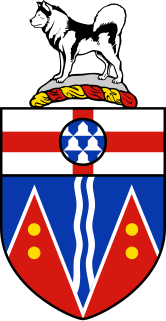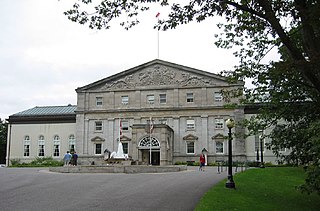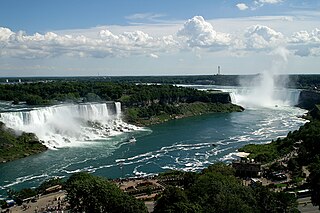
The coat of arms of Yukon is the heraldic symbol representing the Canadian territory of Yukon. The arms was commissioned by the federal Department of Indian Affairs and Northern Development and designed by well-known heraldry expert Alan Beddoe in the early 1950s. It was officially approved by Queen Elizabeth II in 1956.

In heraldry, an ordinary is a simple geometrical figure, bounded by straight lines and running from side to side or top to bottom of the shield. There are also some geometric charges known as subordinaries, which have been given lesser status by some heraldic writers, though most have been in use as long as the traditional ordinaries. Diminutives of ordinaries and some subordinaries are charges of the same shape, though thinner. Most of the ordinaries are theoretically said to occupy one-third of the shield; but this is rarely observed in practice, except when the ordinary is the only charge.

The coat of arms of Toronto, Ontario, Canada, was designed by Robert Watt, the Chief Herald of Canada at the time, for the city after its amalgamation in 1998. The arms were granted by the Canadian Heraldic Authority on January 11, 1999.

The lozenge in heraldry is a diamond-shaped charge, usually somewhat narrower than it is tall. It is to be distinguished in modern heraldry from the fusil, which is like the lozenge but narrower, though the distinction has not always been as fine and is not always observed even today. A mascle is a voided lozenge—that is, a lozenge with a lozenge-shaped hole in the middle—and the rarer rustre is a lozenge containing a circular hole in the centre. A field covered in a pattern of lozenges is described as lozengy; similar fields of mascles are masculy, and fusils, fusily. In civic heraldry, a lozenge sable is often used in coal-mining communities to represent a lump of coal.
Assiniboine Herald of Arms is the title of one of the officers of arms at the Canadian Heraldic Authority in Ottawa. Like the other heralds at the Authority, the name is derived from the Canadian river of the same name. The design of the badge of office of Assiniboine Herald of Arms is based on the meaning of the word "Assiniboine." This is an Ojibway term describing the practice of boiling food by dropping heated rocks into water. The black circle represents the rim of a pot, looking from the top down. The red illustrates the heat from the rocks in the pot.
Athabaska Herald of Arms is the title of one of the officers of arms at the Canadian Heraldic Authority in Ottawa. Like the other heralds at the Authority, the name is derived from that of a Canadian river. The design of the badge of office of Athabaska Herald of Arms is based on the floral emblem of the province of Alberta, the wild rose. It is placed over two traditional Athapascan copper knives, honouring this native linguistic group and the great river and region of Northwestern Canada, which share various spellings of this name. The office of Athabaska Herald of Arms was created in 1988 at the same time as the Canadian Heraldic Authority, although it is currently vacant.
Fraser Herald of Arms is the title of one of the officers of arms at the Canadian Heraldic Authority in Ottawa. Like the other heralds at the Authority, the name is derived from the Canadian river of the same name. Since the inception of the office, Fraser Herald of Arms has been the principal artist of the Canadian Heraldic Authority. As such, Fraser is responsible for overseeing the artwork created for all grants of arms emanating from the Authority.
Saguenay Herald of Arms is the title of one of the officers of arms at the Canadian Heraldic Authority in Ottawa. Like the other heralds at the Authority, the name is derived from the Canadian river of the same name. Saguenay Herald of Arms is the Assistant Registrar of the Canadian Heraldic Authority. As such, Saguenay assists Saint-Laurent Herald in the registration duties. Together they also have specific responsibilities for the bilingual texts of the grant and registration documents.
Saint-Laurent Herald of Arms is the title of one of the officers of arms at the Canadian Heraldic Authority in Ottawa. Like the other heralds at the Authority, the name is derived from a Canadian river, in this case the Saint Lawrence River. In addition to his/her regular heraldic duties, Saint-Laurent Herald, as the Registrar of the Canadian Heraldic Authority, is responsible for maintaining the Public Register of Arms, Flags and Badges of Canada.

Outaouais Herald of Arms Emeritus is the title of one of the officers of arms at the Canadian Heraldic Authority in Ottawa. Herald Emeritus is an honorary position reserved for former heralds who have given distinguished service. Like the other heralds at the Authority, the name is derived from a Canadian river, in this case the Ottawa River.

Coppermine Herald of Arms is the title of one of the officers of arms at the Canadian Heraldic Authority in Ottawa. The office was created in 2003 and Coppermine Herald is the assistant artist of the Authority. Like the other heralds at the Authority, the name is derived from the Canadian river. The design of the badge of office of Coppermine Herald of Arms was assigned on 15 June 2005. The ulu in the badge is a traditional Inuit knife that has existed for over 4000 years. It honours the northern people and land. Its copper colour refers to the title Coppermine Herald. Since the creation of the office, it has been held by Catherine Fitzpatrick.

Miramichi Herald of Arms is the title of one of the officers of arms at the Canadian Heraldic Authority in Ottawa, Ontario, Canada. The office was created in 2003. Like the other heralds at the Authority, the name is derived from a Canadian river. The design of the badge of office of Miramichi Herald of Arms was assigned on 15 June 2005.
Dauphin Herald of Arms Extraordinary is the title of one of the officers of arms at the Canadian Heraldic Authority in Ottawa. Herald Extraordinary is an honorary position reserved for people who have made notable contributions to Canadian heraldry. Like the other heralds at the Authority, the name is derived from the Canadian river of the same name.

Cowichan Herald of Arms Extraordinary is the title of one of the officers of arms at the Canadian Heraldic Authority in Ottawa. Herald Extraordinary is an honorary position reserved for people who have made notable contributions to Canadian heraldry. Like the other heralds at the Authority, the name is derived from the Canadian river of the same name.
Rouge Herald of Arms Extraordinary is the title of one of the officers of arms at the Canadian Heraldic Authority in Ottawa. Herald Extraordinary is an honorary position reserved for people who have made notable contributions to Canadian heraldry. Like the other heralds at the Authority, the name is derived from the Canadian river of the same name.
Capilano Herald of Arms Extraordinary is the title of one of the officers of arms at the Canadian Heraldic Authority in Ottawa. Herald Extraordinary is an honorary position reserved for people who have made notable contributions to Canadian heraldry. Like the other heralds at the Authority, the name is derived from the Canadian river of the same name. The badge makes reference to the salmon run on the Capilano River and to the artistry of the Squamish First Nations people.
Albion Herald of Arms Extraordinary is the title of one of the officers of arms at the Canadian Heraldic Authority in Ottawa. Herald Extraordinary is an honorary position reserved for people who have made notable contributions to Canadian heraldry. Like the other heralds at the Authority, the name is derived from a Canadian River. Initially, there was some indication that the office would be given the title "Red Hill," but when informed that the Red Hill River is today in essence a sewer, the CHA decided to name the position "Albion," the river's name in a less polluted era.

The coat of arms of Burnaby was granted originally to the Corporation of the District of Burnaby by the Canadian Heraldic Authority in 1991, and then reconfirmed for the City of Burnaby in 2005 as the Corporation's successor. The grant included the full coat of arms as well as a flag and a badge, both derived from the arms.
A heraldic authority is defined as an office or institution which has been established by a reigning monarch or a government to deal with heraldry in the country concerned. It does not include private societies or enterprises which design and/or register coats of arms.















